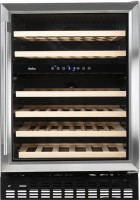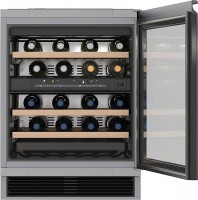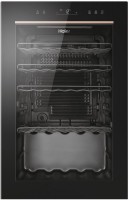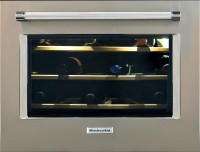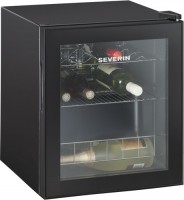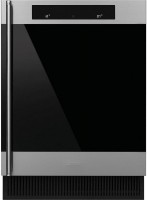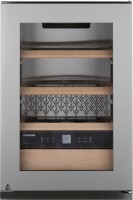Wine Coolers Liebherr
All Wine Coolers Advanced filters → |
You might be interested in
Wine Coolers: specifications, types
Number of bottles
The maximum number of standard wine bottles (straight, Bordeaux type) that the cooler is designed to store.
The increase in capacity affects the dimensions and price of the entire device. So for private home use, a compact wine coolers of small capacity (up to 20 bottles) can be the best choice — especially since the height of such devices is usually small. However, low wine coolers can store more contents — 24 – 25 bottles or more. Models with a capacity of 50 – 80 bottles are already designed mainly for bars and restaurants, but they can also be useful for enthusiastic wine collectors; and the most voluminous of modern wine coolers can hold noticeably more than 80 bottles — in some units up to two or three hundred.
It is also worth noting that it is not recommended to fill wine coolers to their full capacity. The actual occupancy should be at least 30 percent lower than the maximum. So, when choosing, it is worth making an appropriate margin.
The increase in capacity affects the dimensions and price of the entire device. So for private home use, a compact wine coolers of small capacity (up to 20 bottles) can be the best choice — especially since the height of such devices is usually small. However, low wine coolers can store more contents — 24 – 25 bottles or more. Models with a capacity of 50 – 80 bottles are already designed mainly for bars and restaurants, but they can also be useful for enthusiastic wine collectors; and the most voluminous of modern wine coolers can hold noticeably more than 80 bottles — in some units up to two or three hundred.
It is also worth noting that it is not recommended to fill wine coolers to their full capacity. The actual occupancy should be at least 30 percent lower than the maximum. So, when choosing, it is worth making an appropriate margin.
Built-in installation
It is models that could be built into furniture, wall niches, etc. Some built-in wine coolers, relatively small in size, can even be installed under the countertop — quite a convenient option for use in the kitchen. Anyway, built-in appliances installation is somewhat more complicated than free-standing, but such devices can easily fit into almost any interior without much difficulty.
Note that some models in this category cou...ld be only built-in; others are universal and allow separate installation.
Note that some models in this category cou...ld be only built-in; others are universal and allow separate installation.
Type
— Climatic. Wine coolers with one temperature zone: one temperature is maintained throughout the entire volume of the working chamber. Such models are designed only for storing wines; different types at the same time (red, white, etc.) — they can all be normally stored at the same temperature. But the optimal serving temperature is just different, and a temperature cooler is better suited to prepare for serving.
— Temperature.... Coolers with several zones with separate temperature control. The meaning of this design lies primarily in the fact that different types of wine have different recommended serving temperatures, which, moreover, differ from the optimal storage temperature; see "Temperature zones" for details.
— Temperature.... Coolers with several zones with separate temperature control. The meaning of this design lies primarily in the fact that different types of wine have different recommended serving temperatures, which, moreover, differ from the optimal storage temperature; see "Temperature zones" for details.
Temperature zones
The number of temperature zones provided in the working chamber of the wine cooler.
The temperature zone is a part of the working chamber with its temperature mode, independent of the rest of the volume. In climatic coolers (see "Product type") there is only one such zone — this is quite enough for storing wines, even different types. But it is recommended to serve different types of wine at different temperatures, and all these temperatures differ fr...om the 10..12 °C required for storage. Accordingly, additional temperature zones are desirable in preparation for serving. Moreover, the more these zones, the more types of wines can be kept ready for serving at the same time, but the more expensive the unit is. Thus, most multi-temperature models have only two zones — for storage and for serving; the latter can be reconfigured for different types of wines. More zones — 3 or more — are found mainly in high-end high-capacity coolers.
The temperature zone is a part of the working chamber with its temperature mode, independent of the rest of the volume. In climatic coolers (see "Product type") there is only one such zone — this is quite enough for storing wines, even different types. But it is recommended to serve different types of wine at different temperatures, and all these temperatures differ fr...om the 10..12 °C required for storage. Accordingly, additional temperature zones are desirable in preparation for serving. Moreover, the more these zones, the more types of wines can be kept ready for serving at the same time, but the more expensive the unit is. Thus, most multi-temperature models have only two zones — for storage and for serving; the latter can be reconfigured for different types of wines. More zones — 3 or more — are found mainly in high-end high-capacity coolers.
Total volume
The total volume of the wine cooler working chamber (chambers).
Although the main spec of such units is the number of bottles (see above), volume data can also be useful when evaluating and comparing different models. The fact is that with the same capacity, a larger volume means better air circulation and more efficient temperature distribution. On the other hand, an increase in volume also increases the price and dimensions — and there may simply not be free space for a wide or high wine cooler.
Although the main spec of such units is the number of bottles (see above), volume data can also be useful when evaluating and comparing different models. The fact is that with the same capacity, a larger volume means better air circulation and more efficient temperature distribution. On the other hand, an increase in volume also increases the price and dimensions — and there may simply not be free space for a wide or high wine cooler.
Minimum temperature
It is the lowest temperature in the working chamber that the model can provide.
Note that the optimal temperature for storing different wines is the same — about 10..12 °C; in this mode, almost any wine cooler can work. And lower temperatures may be needed primarily to prepare different types of wine for serving. So, the optimal temperature for most white and rosé wines is considered to be 8...12 °C. However, a lower t...emperature may be required, and sparkling wines (champagne) are usually served "icy", with a temperature not exceeding 7 °C. One can be found more detailed recommendations on this matter in special sources. In addition, lowering the temperature may be required for storage — it slows the process of wine maturation.
Anyway, the lower the minimum temperature in the wine cooler, the wider the possibilities for setting the climate.
Note that the optimal temperature for storing different wines is the same — about 10..12 °C; in this mode, almost any wine cooler can work. And lower temperatures may be needed primarily to prepare different types of wine for serving. So, the optimal temperature for most white and rosé wines is considered to be 8...12 °C. However, a lower t...emperature may be required, and sparkling wines (champagne) are usually served "icy", with a temperature not exceeding 7 °C. One can be found more detailed recommendations on this matter in special sources. In addition, lowering the temperature may be required for storage — it slows the process of wine maturation.
Anyway, the lower the minimum temperature in the wine cooler, the wider the possibilities for setting the climate.

